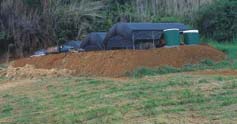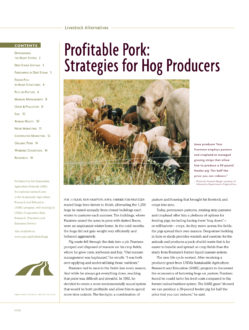
Soil Health
Soil improvement is a built-in benefit of alternative swine systems. Some producers plan their grazing strategies not only to manage the pasture, but also to build the soil for other commodities, such as feed grain or cash crops. Planning a rotation with crops that both improve soil and complement a hog operation makes doubly good sense. Oats, for example, can provide straw for bedding and nutritious feed for sows. Moreover, raising pigs on pasture growing on ground that previously raised a crop can break pest and disease cycles in the rotation.
Manure improves the organic matter content and overall quality of the soil whether deposited by grazing animals or applied as compost from hoop structures.
Frantzen of New Hampton, Iowa, also raises brood cows, alternating the livestock through the same paddocks. Rotating both cows and hogs through the pastures has helped the soil, he said. 'Either one of the livestock groups on their own would make it hard to manage the ground cover,' he said. 'But I've noticed that when they rotate through the same pasture, hogs and cattle will eat a wider range of plants and improve soil stability.'
Animal Health
Increasingly, confinement systems have been found to have adverse effects on hog health and well-being. Studies from the United States and abroad report that animals raised in confinement experience increased aggression, higher incidence of abnormal behavior, decreased response to external stimuli, and numerous physical and chemical indicators of stress, such as shoulder lesions from rubbing on crates and flooring and diarrhea in piglets.
Toxic gases such as methane, ammonia and hydrogen sulfide can threaten hog health, particularly in older confinement facilities, or when ventilation systems fail. Even at lower concentrations, these gases can lead to decreased respiratory function.
Dust in swine facilities may contain particles of feed, feces, dried urine, swine dander, pollen, insect parts, mineral ash, mold and bacteria, according to 1999 articles in the Journal of Agromedicine and the Journal of Agricultural Engineering Research. Those biological, chemical and physical components of dust are blamed for elevated mortality and incidence of pneumonia, rhinitis and pleuritis, among other conditions reported in pig houses.
In confinement facilities, producers need efficient ventilation systems with high airflow volume to rid the structures of dust and gases. By contrast, hoop structures or pasture systems do not require automated ventilation systems. Outdoor systems may have greater incidence of internal parasites, however, as discussed below.
Producers can anticipate that hogs raised in deep bedding or on pasture likely will have fewer respiratory diseases and foot and leg problems. Most producers using conventional systems routinely add antibiotics to feed or water to help prevent disease or stimulate growth.
Dave Serfling of Preston, Minn., who successfully converted an old farm building into a deep straw wean-to-finish facility, observed greater health benefits for his pigs. He had pasture-farrowed hogs for 25 years, but with help from a SARE grant, added a winter deep straw system. What he saw impressed him almost all of his pigs reached 240 pounds by six months of age without the use of antibiotics. Moreover, pig mortality was less than 1 percent.
'It worked so well to have mothers with their pigs that we call our remodeled hog house a pre-wean to finish facility,' he said, attributing the better health to the combination of straw, fresh air and sunshine.
To prevent disease, experts recommend moving entire groups of hogs. 'Strict all in/all out grouping is very beneficial to the health status and growth performance of pigs,' Honeyman said. 'This works best with a proper facility layout where pigs are born in a narrow time window and sows avoid cross suckling of older and newborn pigs.'
Producers will need to take a proactive approach with internal parasite control. The eggs of many worms persist in soil for years. Water and feed dewormers are effective forms of control, and Honeyman recommends following a year-round, whole-herd life cycle health program that includes post-mortem exams, fecal samples, slaughter checks and blood tests to help diagnose pathogens and parasites.
